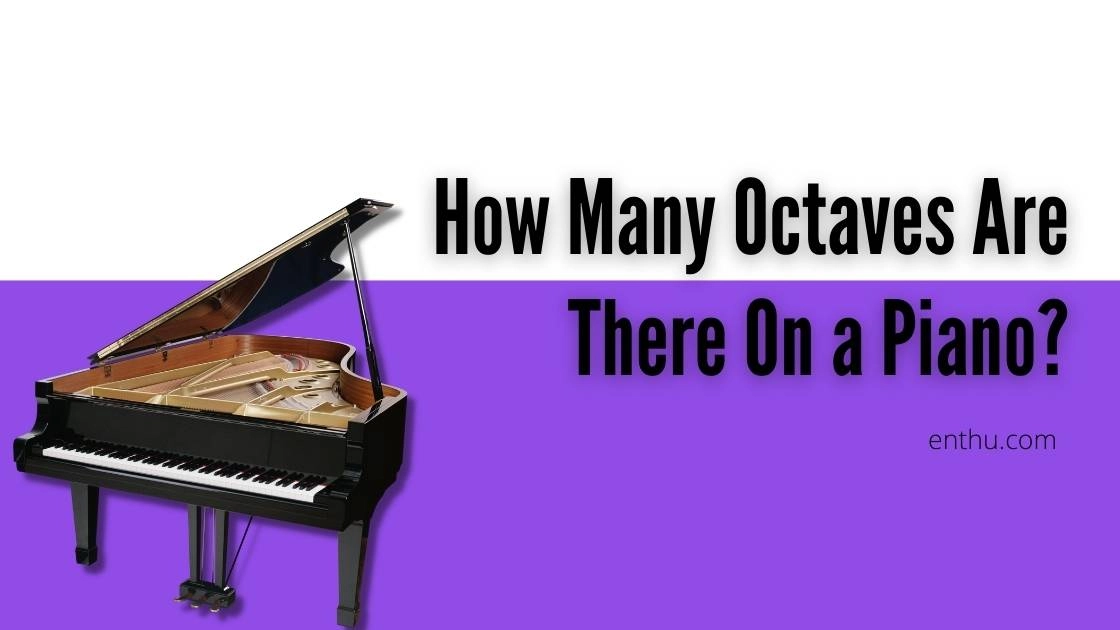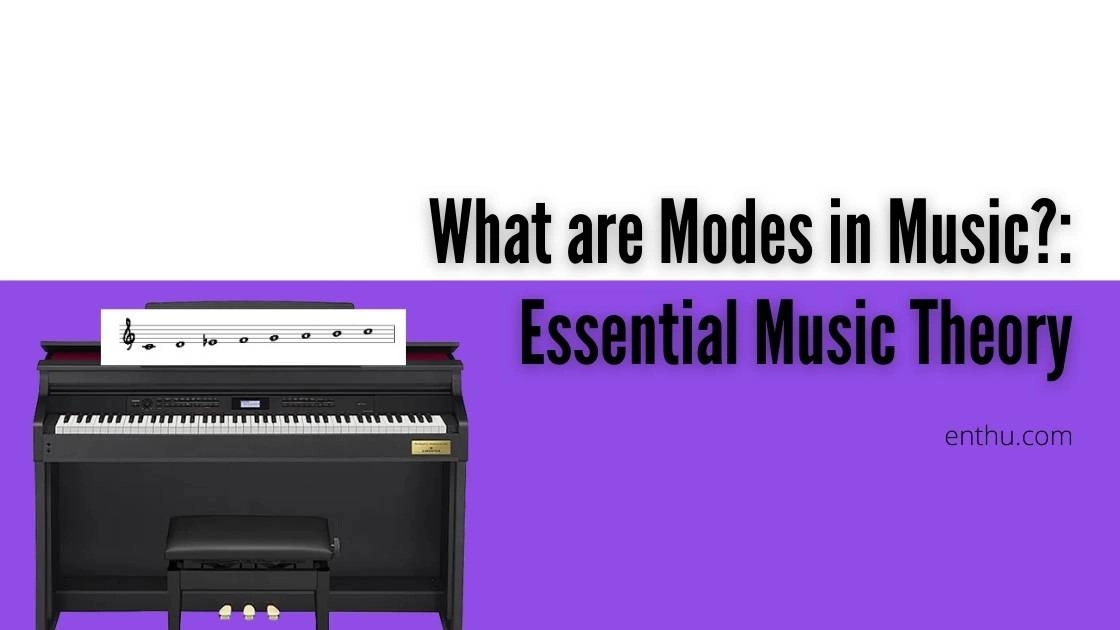"I am a moody person. I carry mixed moods", she said ambiguously. Well, ambiguous emotions are unhealthy and worst. However, they are essential as they give meaning to life.
Do you know music also has moods? When you hear a musical piece, it makes you feel like dancing. In contrast, some melodies make your heart heavy. How? Because of the musical modes that can even change the listener's moods.
What are Modes in Music?
Before you know the modes, you first need a basic understanding of music theory and musical terms.
1. Musical Terms You Must Know
Musical
Notes A set of 12 notes is called as Musical Notes. It includes C C# D D# E F F# G G# A A# B (C)
Scale
A set and series of 7 musical notes called as a Scale. Such as C Major scale - C D E F G A B (C)
Octave
The series of 8 notes including the root note, is called an Octave.

Mode
When you change the root note of a scale by keeping the same set of notes, it is called as Mode, which is a series of notes derived from the original.
For example, C Ionian is the first mode that starts with C, and D Dorian is the 2nd mode that starts on the D note.
Intervals
The distance between two consecutive notes is known as an Interval such as C to C# or C to D.
Tonal
Center/Tonic When a tune comfortably and frequently lands on a particular pitch, that pitch is called Tonal Center or Tonic, like C note in C Major scale. Each note has a pitch.
So if you go from C to C, it forms a scale. Moreover, it is also known as Mode. You might be thinking about where to use the word mode or scale, as both are collections of notes in a distinct order.
C Major scale is also a C Ionian Mode. How are they different then? Let's move ahead and clear it.
Are Scales and Modes the Same?
A scale is a series of notes with a base that is root note. On the other hand, a Mode is derived from a scale itself, where you consider any note as a root note and you get a new mode with different sounds. Relax.
I know it has got all confusing. Let me simplify this for you. Do you remember about tonal center? So, in the C Major scale (C D E F G A B), C is a type of tonal center. C is the key. So everything you play in the C Major will resolve on the C. Further, keeping the C Major scale, if you consider D a tonal center and start with D like D E F G A B C D, you get the second mode.
So, based on the theory, you can take any note out of the 7 notes, make it a tonal center, and play the same notes. You will get a new scale, which will be a new Mode. In a nutshell, the C Major scale is a natural yet original pattern.
At the same time, Mode is usually reserved for classifying the other patterns obtained from the original. Thus, the C Major scale is also known as C Ionian Mode.
How Many Modes are There?
The 7 Musical Modes
There are seven modes in music theory: Ionian, Dorian, Phrygian, Lydian, Mixolydian, Aeolian, and Locrian.
These are also called Church Modes because they originated from early church music. Over time, they found their place not only in classical compositions, but also in jazz, pop, and modern music.
Some modes carry a bright, major feel, while others sound darker and minor.
And yes—though the names may sound a bit unusual, they come with a rich and ancient history that continues to shape music even today.
1. History of Modes
It is believed that modes are derived from Ancient Greece, which is why they have Greek names. Hence, they are also recognized as Greek Modes.
Greek philosophical writings of both Plato and Aristotle acknowledged modes.

Finally, let's learn about the modes:

2. 7 Modes in Music
Let's understand modes with a base of the C Major scale:
Ionian
As we have discussed above, you already know that the C Major scale is also known as C Ionian Mode.
Here, the tonal center is C, with all the natural notes and white keys. You can try practicing which major scale C has as its first note. The answer will be C Ionian mode.
Dorian
The 2nd pattern derived from the C major scale starts on D as D E F G A B C, and that is called Dorian Mode. You can also address it as D Dorian mode. It has a minor sound with a flat 3rd and 7th.
Phrygian
Phrygian is the 3rd mode borne out of the C Major scale. It starts on E note and goes like E F G A B C D. So the Phrygian mode includes flat 2nd, 3rd, 6th, and 7th.
Lydian
Which major scale has F as its 4th note? Yes, F Lydian mode goes from F G A B C D E. Lydian mode has a kind of bright sound. It's a major scale with just one change as of the C Ionian, a raised 4th.
Mixolydian
Mixolydian is the 5th mode. If you play the white keys from G to G, it forms a Mixolydian mode. This mode is a major scale and includes a flat 7.
Aeolian
It's just another name for the natural minor scale. It's the 6th mode after Mixolydian mode. You must play from A B C D E F G to A to form an Aeolian mode. This mode is similar to the Dorian mode. The only difference is that the Aeolian mode also includes a minor 6th.
Locrian
Locrian is the 7th mode that goes from B C D E F G A to B. This mode consists of flat 2nd, 3rd, 5th, 6th, and 7th. This mode is the minor scale with a restless feel.
You're playing the same notes as in the C major scale, but you are playing a completely different mode. Learning modes are not that complex. You need to understand the essential music theory and its application.
Other Perspectives of Understanding Modes
Intervals A mode is a collection of notes that each shares a relationship. So relationship means the distance between two consecutive notes like C to D or D to E. This interval can be a Half step (Semitone) or a Whole step (Whole-tone).
The smallest interval is a half step, such as C to C#. In short, two half steps make one whole step. Whereas the whole step is the largest interval, double the distance of semitone. It's like skipping a note. For example, C to D is a whole step where we skipped C#.
Importance of Musical Intervals
The arrangement of each note in mode is the structure of the whole step and half step.
If we take C Major or C Ionian as an example, the series of the interval will look like this- C to D - Whole step D to E - Whole step E to F - Half step F to G - Whole step G to A - Whole step A to B - Whole step B to C - Half step Numerically, the interval will be 1 1 ½ 1 1 1 ½ So, now, if we start from the 2nd mode of the major scale that is D, the interval pattern will change like 1 ½ 1 1 1 ½ 1
Once you understand the pattern, you can apply it to any root note you want. For example, if you take E as Ionian, you can go like, which major scale has E as its first note, and the answer will be E Major scale.
Similarly, if you want to see E as Dorian, you can say which major scale has E as its 2nd note, and the answer will be D Major scale. So, E Dorian is the same as the D Major scale.

Why Are Modes Important?
In the mid-20th century, jazz musicians started using modes as a basic framework for their compositions. According to Plato, the impactfulness of modes could even change someone's state of mind and behavior.
He recommended the soldiers listen to musical pieces in the Dorian or Phrygian modes to feel stronger. At the same time, advised them to stay away from the melodies in Ionian or Lydian modes, which will make them sentimental.
Famous Songs Using Musical Modes
Miles Davis's most famous album,
Miles Davis’s "kind of blue," and one of the tracks called "so what," made immense use of the Dorian mode.
John Coltrane's cover of "my favorite things" also used the Dorian mode but included a combination of modes to create colorful sounds.


Conclusion
Each scale or mode is unique. Different modes have different colors and flavors. It sounds different with its quality and feel. You can easily learn them by going through the above guide.
Though consistent practice can help you get better at piano, a good teacher can teach you better skills. Once you learn the piano scales and technique, you will experience the beauty of musical modes. So, go ahead. Achieve your musical dream!

FAQs
1) How to identify modes?
To identify a mode, you must first find the tonic or tonal center. Listen to the entire series of notes properly and try to get the feel out of it like major or minor.
Go through the above theory and characteristics of notes. It will become easier for you to recognize modes.
2) How do I memorize modes?
I have a very creative yet simple trick for you. Remember this sentence - I Danced Perfectly Like My Aunt Laura.
The first letter of every word starts with a mode such as I-Ionian, D-Dorian, P-Phrygian, L-Lydian, M-Mixolydian, A-Aeolian, and L-Locrian.





Comments